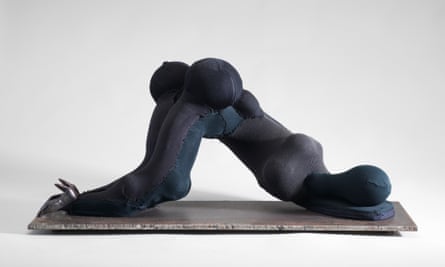On a loose sheet of paper from 1995, when she was in her 80s, Louise Bourgeois wrote: “The beautiful clothes from your youth – so what – sacrifice / them, eaten by the moths.” The statement represented a turning point in the French-American artist’s life and work. Schooled in the importance of self-presentation since childhood, Bourgeois observed that the “beautiful clothes” of her youth were, by this stage, amassing dust in her Manhattan townhouse. But to sacrifice them didn’t mean to dispose of them. She took up the needle and began to repurpose her clothing in a new sequence of fabric works – textile figures, collages, tactile drawings, books, prints.
Bourgeois is known for her “spider” sculptures: towering arachnids carved in foreboding bronze and stainless steel. But the spider, as she frequently reminded her spectators, is also a deft weaver and repairer – and working with fabric was always part of her life. Born in Paris in 1911, she grew up mending vintage tapestries as the daughter of a seamstress. After a stint selling books in the family’s Paris showroom, she met Robert Goldwater, an American art historian. Wanting to escape France, she married him and relocated in 1938 to New York City, where she would remain and build an astonishing career until her death in 2010.
Bourgeois’s fabric works are now on display in The Woven Child, a major retrospective at London’s Hayward Gallery. Though the title references the artist’s origins, the focus of the exhibition is a late chapter in her output, from the mid-1990s to 2010. Working night and day in her townhouse, she returned to cloth as medium, creating a version of her parents’ atelier in her home and revisiting the decades of couture that her fashion-conscious father had encouraged her to wear from a young age. The capacious show surveys close to 90 works, often displaying jagged, running stitches, and edges that are ripped and fraying.
Being in the presence of Bourgeois’s creations is unnerving, at times disturbing and unsettling. There are severed heads; exposed bodily orifices; bulbous and dismembered dolls. Hayward director Ralph Rugoff reflects: “It’s easy to go to art shows these days when you don’t have a strong emotional response to the work. No one has gone so far out as Bourgeois did in terms of pushing an edge; not that many artists so radically undo our idea of form.”
The works refute the classical view of the female body as a glossy object or passive muse. Endless Pursuit (2000), a blue-cloth feminine figure with flattened breasts and an enormous, globe-like belly, articulates the anguish that can come with trying to conceive. Lady in Waiting (2003) satirises the housewife waiting for a man to come home by making her a violent insect, seething on a plush tapestry chair. The works probe what inhabiting a body feels like, as opposed to how it looks.
Since her death, Bourgeois has been celebrated, sometimes caricatured as a triumphant “spider woman”, or “ladyboss” of contemporary art. The Woven Child makes a case for her work instead as vibrantly material and three-dimensional. It is deeply moving to encounter the artist’s determination to make something from the scraps and traces of her childhood – and save the pieces of a life from “the moths”.
Stitches in time – four works by Louise Bourgeois
Couple IV, 1997

An entwined, headless couple lies prostrate in a vitrine. The glass case creates a claustrophobic feeling. The piece comments on the oppressive nature of intimate relationships but also our desperate need to feel close to other people.
The Good Mother, 2003 (pictured top)
On initial viewing, it could be a straightforward ode to Bourgeois’s mother, Joséphine. Yet threads issuing from the nipples suggest women’s entrapment in webs of reproductive duty. The title’s reference to being “good” evokes psychoanalyst Donald Winnicott’s model of the “good enough mother”, but also the trope of the “good girl” Bourgeois sought to expunge and reject through her work.
High Heels, 1998

Adapted from a sequence of pencil drawings Bourgeois made of female cats in heat, High Heels presents an ambiguous feminine form both warped and enraptured by a pair of shoes. The piece evokes the ambivalent pursuits of fashion and femininity, how they straddle both pleasure and pain. “There is no better image for everything that fashion wants you to forget,” says Rugoff.
Single 1, 1996

The work precariously dangles a roughly stitched, ambiguously gendered figure from a circular hook. A sense of surrender and intense vulnerability confronts the viewer. Bourgeois has said: “My early work is the fear of falling. Later on it became the art of falling. […] Later it became the art of hanging in there.”
Louise Bourgeois: The Woven Child is at the Hayward Gallery, London, to 15 May
